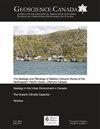新不伦瑞克省Passamaquoddy湾海岸火山带晚志留纪Eastport组的火山作用
IF 1.8
4区 地球科学
Q3 GEOSCIENCES, MULTIDISCIPLINARY
引用次数: 0
摘要
这次实地考察是在新不伦瑞克省西南部Passamaquoddy湾地区(Eastport Formation)暴露的志留纪、长英质为主的双峰火山和沉积序列的精致、近乎原始的暴露中进行的。这些岩石形成了从新不伦瑞克西南部延伸到缅因州南部海岸的海岸火山带的西北延伸。该序列意义重大,因为它是一个大型双峰火成岩省的一部分,有证据表明超火山规模的喷发始于盐度造山运动结束时(约424 Ma),并持续到阿卡迪亚造山运动(421–400 Ma)。岩石的地球化学特征可以用与伸展有关的火山活动来解释,但伸展的具体驱动因素尚不确定。Passamaquody湾层序厚度为4km,由四个玄武岩-流纹质火山活动旋回组成。在1-3旋回中,玄武岩火山作用通常先于流纹岩火山作用。旋回4代表火山活动的减弱阶段,主要由潮缘沉积物和玄武岩火山岩组成。代表了一系列喷发和侵位机制,从玄武岩流和火山碎屑渣矿床的夏威夷和斯特龙博安型火山活动,到形成火山碎屑密度流(PDC)和高级流变熔结凝灰岩的高爆炸性亚普林阶至普林阶流纹岩火山碎屑喷发。在这次实地考察中,我们将检查说明这一系列喷发和侵位过程的关键暴露,以及它们的诊断特征,以及镁铁质和长英质岩浆之间相互作用的证据,以及由于潮湿潮缘沉积物上的流侵位而形成的各种泥质角砾岩。还将考虑沉积环境和大量双峰火山活动对构造模型的限制。本文章由计算机程序翻译,如有差异,请以英文原文为准。
Volcanism of the Late Silurian Eastport Formation of the Coastal Volcanic Belt, Passamaquoddy Bay, New Brunswick
This field trip is an excursion through the exquisite, nearly pristine exposures of a Silurian, felsic-dominated bimodal volcanic and sedimentary sequence exposed in the Passamaquoddy Bay area of southwestern, New Brunswick (Eastport Formation). These rocks form the northwest extension of the Coastal Volcanic Belt that extends from southwestern New Brunswick to the southern coast of Maine. The sequence is significant because it is part of a large bimodal igneous province with evidence for supervolcano-scale eruptions that began to form during the close of the Salinic Orogeny (about 424 Ma), and continued into the Acadian Orogeny (421–400 Ma). The geochemical characteristic of the rocks can be explained by extension related volcanism but the specific drivers of the extension are uncertain. The Passamaquoddy Bay sequence is 4 km thick and comprises four cycles of basaltic-rhyolitic volcanism. Basaltic volcanism typically precedes rhyolitic volcanism in Cycles 1–3. Cycle 4 represents the waning stages of volcanism and is dominated by peritidal sediments and basaltic volcanics. A spectrum of eruptive and emplacement mechanisms is represented ranging from the Hawaiian and Strombolian-type volcanism of the basaltic flows and pyroclastic scoria deposits, to highly explosive sub-Plinian to Plinian rhyolitic pyroclastic eruptions forming pyroclastic density currents (PDC) and high grade rheomorphic ignimbrites. During this field trip we will examine key exposures illustrating this spectrum of eruptive and emplacement processes, and their diagnostic characteristics, along with evidence for the interaction between mafic and felsic magmas and a variety of peperitic breccias formed as a result of emplacement of flows on wet peritidal sediments. The constraints the depositional setting and voluminous bimodal volcanism places on tectonic models will also be considered.
求助全文
通过发布文献求助,成功后即可免费获取论文全文。
去求助
来源期刊

Geoscience Canada
地学-地球科学综合
CiteScore
3.30
自引率
0.00%
发文量
9
审稿时长
>12 weeks
期刊介绍:
Established in 1974, Geoscience Canada is the main technical publication of the Geological Association of Canada (GAC). We are a quarterly journal that emphasizes diversity of material, and also the presentation of informative technical articles that can be understood not only by specialist research workers, but by non-specialists in other branches of the Earth Sciences. We aim to be a journal that you want to read, and which will leave you better informed, rather than more confused.
 求助内容:
求助内容: 应助结果提醒方式:
应助结果提醒方式:


